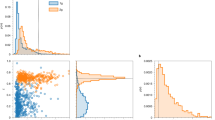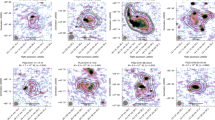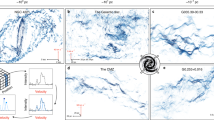Abstract
Massive galaxy clusters are filled with a hot, turbulent and magnetized intra-cluster medium. Still forming under the action of gravitational instability, they grow in mass by accretion of supersonic flows. These flows partially dissipate into heat through a complex network of large-scale shocks1, while residual transonic (near-sonic) flows create giant turbulent eddies and cascades2,3. Turbulence heats the intra-cluster medium4 and also amplifies magnetic energy by way of dynamo action5,6,7,8. However, the pattern regulating the transformation of gravitational energy into kinetic, thermal, turbulent and magnetic energies remains unknown. Here we report that the energy components of the intra-cluster medium are ordered according to a permanent hierarchy, in which the ratio of thermal to turbulent to magnetic energy densities remains virtually unaltered throughout the cluster’s history, despite evolution of each individual component and the drive towards equipartition of the turbulent dynamo. This result revolves around the approximately constant efficiency of turbulence generation from the gravitational energy that is freed during mass accretion, revealed by our computational model of cosmological structure formation3,9. The permanent character of this hierarchy reflects yet another type of self-similarity in cosmology10,11,12,13, while its structure, consistent with current data14,15,16,17,18, encodes information about the efficiency of turbulent heating and dynamo action.
This is a preview of subscription content, access via your institution
Access options
Subscribe to this journal
Receive 51 print issues and online access
$199.00 per year
only $3.90 per issue
Buy this article
- Purchase on Springer Link
- Instant access to full article PDF
Prices may be subject to local taxes which are calculated during checkout



Similar content being viewed by others
References
Miniati, F. et al. Properties of cosmic shock waves in large-scale structure formation. Astrophys. J. 542, 608–621 (2000)
Vazza, F., Brunetti, G., Gheller, C., Brunino, R. & Brüggen, M. Massive and refined. II. The statistical properties of turbulent motions in massive galaxy clusters with high spatial resolution. Astron. Astrophys. 529, A17 (2011)
Miniati, F. The Matryoshka run: a Eulerian refinement strategy to study the statistics of turbulence in virialized cosmic structures. Astrophys. J. 782, 21 (2014)
Zhuravleva, I. et al. Turbulent heating in galaxy clusters brightest in X-rays. Nature 515, 85–87 (2014)
Schlüter, A. & Biermann, I. Interstellare Magnetfelder. Z. Naturforsch. A 5, 237 (1950)
Cho, J., Vishniac, E. T., Beresnyak, A., Lazarian, A. & Ryu, D. Growth of magnetic fields induced by turbulent motions. Astrophys. J. 693, 1449–1461 (2009)
Ryu, D., Kang, H., Cho, J. & Das, S. Turbulence and magnetic fields in the large-scale structure of the Universe. Science 320, 909–912 (2008)
Beresnyak, A. Universal nonlinear small-scale dynamo. Phys. Rev. Lett. 108, 035002 (2012)
Miniati, F. The Matryoshka run. II. Time-dependent turbulence statistics, stochastic particle acceleration, and microphysics impact in a massive galaxy cluster. Astrophys. J. 800, 60 (2015)
Harrison, E. R. Fluctuations at the threshold of classical cosmology. Phys. Rev. D 1, 2726–2730 (1970)
Kaiser, N. Evolution and clustering of rich clusters. Mon. Not. R. Astron. Soc. 222, 323–345 (1986)
Navarro, J. F., Frenk, C. S. & White, S. D. M. A universal density profile from hierarchical clustering. Astrophys. J. 490, 493–508 (1997)
Moore, B. et al. Dark matter substructure within galactic halos. Astrophys. J. 524, L19–L22 (1999)
Clarke, T. E., Kronberg, P. P. & Böhringer, H. A new radio-X-ray probe of galaxy cluster magnetic fields. Astrophys. J. 547, L111–L114 (2001)
Guidetti, D. et al. The intracluster magnetic field power spectrum in Abell 2382. Astron. Astrophys. 483, 699–713 (2008)
Bonafede, A. et al. The Coma cluster magnetic field from Faraday rotation measures. Astron. Astrophys. 513, A30 (2010)
Govoni, F. et al. Rotation measures of radio sources in hot galaxy clusters. Astron. Astrophys. 522, A105 (2010)
Kuchar, P. & Enßlin, T. A. Magnetic power spectra from Faraday rotation maps. REALMAF and its use on Hydra A. Astron. Astrophys. 529, A13 (2011)
Miniati, F. & Colella, P. Block structured adaptive mesh and time refinement for hybrid, hyperbolic + N-body systems. J. Comput. Phys. 227, 400–430 (2007)
Beresnyak, A. & Miniati, F. Turbulent amplification and structure of intracluster magnetic field. Astrophys. J (submitted)
Landau, L. D. & Lifshitz, E. M. Fluid Mechanics 2nd edn (Course of Theoretical Physics, Butterworth, 1987)
Subramanian, K., Narasimha, D. & Chitre, S. M. Thermal generation of cosmological seed magnetic fields in ionization fronts. Mon. Not. R. Astron. Soc. 271, L15 (1994)
Kulsrud, R. M., Cen, R., Ostriker, J. P. & Ryu, D. The protogalactic origin for cosmic magnetic fields. Astrophys. J. 480, 481–491 (1997)
Miniati, F. & Bell, A. R. Resistive magnetic field generation at cosmic dawn. Astrophys. J. 729, 73 (2011)
Gregori, G. et al. Generation of scaled protogalactic seed magnetic fields in laser-produced shock waves. Nature 481, 480–483 (2012)
Bertone, S., Vogt, C. & Enßlin, T. Magnetic field seeding by galactic winds. Mon. Not. R. Astron. Soc. 370, 319–330 (2006)
Donnert, J., Dolag, K., Lesch, H. & Müller, E. Cluster magnetic fields from galactic outflows. Mon. Not. R. Astron. Soc. 392, 1008–1021 (2009)
Stephens, I. W. et al. Spatially resolved magnetic field structure in the disk of a T Tauri star. Nature 514, 597–599 (2014)
Bernet, M. L., Miniati, F., Lilly, S. J., Kronberg, P. P. & Dessauges-Zavadsky, M. Strong magnetic fields in normal galaxies at high redshift. Nature 454, 302–304 (2008)
Zamaninasab, M., Clausen-Brown, E., Savolainen, T. & Tchekhovskoy, A. Dynamically important magnetic fields near accreting supermassive black holes. Nature 510, 126–128 (2014)
Colella, P. Multidimensional upwind methods for hyperbolic conservation laws. J. Comput. Phys. 87, 171–200 (1990)
Miniati, F. & Martin, D. F. Constrained-transport magnetohydrodynamics with adaptive mesh refinement in CHARM. Astrophys. J. 195 (Suppl.), 5 (2011)
Gaspari, M. & Churazov, E. Constraining turbulence and conduction in the hot ICM through density perturbations. Astron. Astrophys. 559, A78 (2013)
Komatsu, E. et al. Five-year Wilkinson Microwave Anisotropy Probe observations: cosmological interpretation. Astrophys. J. 180 (Suppl.), 330–376 (2009)
Eisenstein, D. J. & Hut, P. HOP: a new group-finding algorithm for N-body simulations. Astrophys. J. 498, 137–142 (1998)
Eke, V. R., Navarro, J. F. & Steinmetz, M. The power spectrum dependence of dark matter halo concentrations. Astrophys. J. 554, 114–125 (2001)
Acknowledgements
This work was supported by a grant from the Swiss National Supercomputing Center (CSCS) under project IDs S419 and S506.
Author information
Authors and Affiliations
Contributions
F.M. carried out the cosmological simulations, computed the turbulence structure functions, derived equations (1), (2) and (3) and wrote most of the text. A.B. analysed the structure functions, testing the self-similar nature of second- and third-order structure functions within the inertial range and computing the dissipation rate. A.B. and F.M. computed the evolution of EB and LA.
Corresponding author
Ethics declarations
Competing interests
The authors declare no competing financial interests.
Extended data figures and tables
Extended Data Figure 1 Generation and cascade of ICM hydromagnetic turbulence.
First the gravitational potential energy is converted into kinetic energy of accretion flows. These generate shear and shocks which, in addition to dissipation, produce fluid instabilities and a baroclinic term, respectively, leading to turbulent flows. Shocks also accelerate particles via the Fermi I mechanism. Shocks do not dissipate tangential flows, which will either generate turbulence, shear or shocks, or a combination thereof. The turbulence cascade includes dissipation of compressible modes at weak shocks, conversion of turbulent to magnetic energy via dynamo action, excitation of plasma waves accelerating relativistic particles via Fermi II mechanism, and viscous dissipation.
Extended Data Figure 2 Spectrum of ICM hydromagnetic turbulent cascade.
Characteristic spectrum of turbulent kinetic energy in the ICM. Solid and dashed lines correspond to the solenoidal (Kolmogorov-like) and the compressional (Burgers-like) velocity field, respectively. On the x axis, from left to right, we have marked the virial scale, Rvir, the injection scale, L, the Ozmidov’s scale, LO, the Alfvén scale, LA, and Kolmogorov’s dissipation scale, ℓdiss. All quantities are time dependent and Ozmidov’s scale is comparable to the injection scale, so at times turbulence in the radial direction could be suppressed by stratification.
Rights and permissions
About this article
Cite this article
Miniati, F., Beresnyak, A. Self-similar energetics in large clusters of galaxies. Nature 523, 59–62 (2015). https://doi.org/10.1038/nature14552
Received:
Accepted:
Published:
Issue Date:
DOI: https://doi.org/10.1038/nature14552
This article is cited by
-
Galaxy clusters enveloped by vast volumes of relativistic electrons
Nature (2022)
-
Small-scale turbulent dynamo in astrophysical environments: nonlinear dynamo and dynamo in a partially ionized plasma
Reviews of Modern Plasma Physics (2021)
-
Fast magnetic field amplification in distant galaxy clusters
Nature Astronomy (2020)
-
MHD turbulence
Living Reviews in Computational Astrophysics (2019)
-
Magnetic Field Amplification in Galaxy Clusters and Its Simulation
Space Science Reviews (2018)
Comments
By submitting a comment you agree to abide by our Terms and Community Guidelines. If you find something abusive or that does not comply with our terms or guidelines please flag it as inappropriate.



